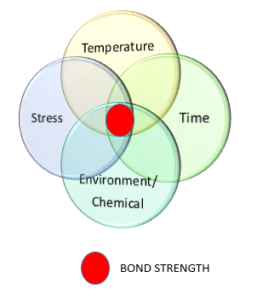Understanding appropriate adhesive removal techniques is important, whether to clean up a spill, disassemble a unit for repair, or simply to know what will cause the bond to fail to avoid bond failure.
 3 Ways to Remove Cured Adhesive
3 Ways to Remove Cured AdhesiveThere are three basic methods of adhesive removal or de-bonding, and each relates to the others and time:
1. Dissolving
2. Thermal
3. Physical Stress
For the fastest removal, combine these methods. For example, to remove cyanoacrylate from a nonporous work surface, one might soak the area in acetone and then scrape the adhesive off.
To remove silicone caulk, a bit of heat with a hot air gun softens the material so you can peel it up.
Even the strongest adhesive bonds can be removed by heating beyond the adhesives’ thermal capability. A blow torch can heat permanent, high strength, threadlockers enough to chemically change them (to burn the adhesive off).
If solvents and thermal removal are undesirable, consider means of physical bond deformation through adhesive or cohesive failure. Adhesive failure causes the adhesive bond to the substrate to fail. Some adhesives are very strong in tensile but have poor peel resistance. Forcing the bond into peel mode may provide you with the desired failure. Very soft adhesives are often desired for their shock-absorbing properties, but these may be torn down the middle. Thus leaving the adhesive on both surfaces but separating the two components all the same.
Refer to the technical product data sheet for thermal resistance, solubility, and clean-up information. Familiarize yourself with any precautions regarding clean-up. For most products, simply wipe up the uncured adhesive with paper towels. However, with cyanoacrylates (instant adhesives), wiping up large spills with paper towels can cause smoke and strong irritating vapors. Flood spilled cyanoacrylate with water which will cause the liquid to cure. Then scrape up the cured materials or dissolve it with acetone.
Please call Permabond to discuss your needs in more detail. Permabond has current leading-edge R&D work in hand which could be of interest in your application.